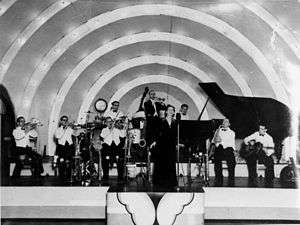Billo Smith
Billo Smith is the stage name used by Australian musician and bandleader[1] William David Smith (1897 - 1973) when he became leader of the Cloudland Dance Band after World War Two.[2][3] Billo played clarinet and alto saxophone.

Early life
Billo was born in Sydney, one of ten children born to Australian born parents. He lived most of his life in Brisbane, leaving Australia only during World War One, when he served in France as a member of the Australian Light Horse brigade. He was wounded in combat in 1916, suffering a shrapnel injury to his face, the left side of which was paralysed for the remainder of his life. He was honourably discharged.
Smith was married to Agnes "Nessie" Smith (1903-1982) who was also a member of the band as the pianist. They remained married for 45 years and had one son, William James Smith (1930- ) who is a clarinet and saxophone player, and band member throughout the 1950s. Billo Smith's son studied music at the Sydney Conservatorium; he also adopted the stage name 'Billo'.
Career
Billo led a band at the Trocadero[4][5] in Brisbane in the run to and during World War Two.
Through the 1950s, Smith's band was the main act at the Cloudland Ballroom in Brisbane.[6] He and his band, including Billo junior,[7] played for Queen Elizabeth II for her coronation tour of Australia when she and Prince Philip visited Brisbane in 1952.[8](Photo and citation). The Royal Command Performance was held in the theatre of the Brisbane Town Hall. Billo Senior pulled a muscle as he began to conduct the band. Billo also played for the Duke of York (Later King George VI) in 1927 and the Duke of Gloucester on two occasions.[8]
Retirement
The Smiths retired from the band in 1960, and moved from Brisbane to the Gold Coast, firstly owning a block of flats at Kirra Beach, and then a living house on Razorback Hill overlooking Coolangatta (1968 until 1982). Billo remained involved in the RSL.
In retirement Smith seldom played his instrument. He had played for a few balls at the Empire Palais in Tweed Heads. Smith served as secretary of the Tweed Heads branch of the Lions Club. He was also a member of the Masonic Lodge in Brisbane, and later in Tweed Heads.[9][10][11]
References
- Stephen Pleskun (2012). A Chronological History of Australian Composers and Their Compositions. Xlibris Corporation. pp. 605–. ISBN 978-1-4653-8226-9.
- James G. Lergessner (1 January 2013). Cloudland: Queen of the Dance Halls. Boolarong Press. pp. 94–. ISBN 978-1-922109-77-4.
- Gaetano Rando; Gerry Turcotte (2007). Literary and Social Diasporas: An Italian Australian Perspective. Peter Lang. pp. 23–. ISBN 978-90-5201-383-1.
- Andrew Bisset (1 July 1988). Black Roots, White Flowers: A History of Jazz in Australia. ABC Enterprises for the Australian Broadcasting Corporation. ISBN 978-0-642-53067-7.
- Todd Barr; Rodney John Sullivan (2005). Words to Walk by: Exploring Literary Brisbane. Univ. of Queensland Press. pp. 71–. ISBN 978-0-7022-3517-7.
- "Rock & Roll Comes to Brisbane". Thesis of Geoffrey Waldin.
- "Billo to set Royal Ball Pace". The Courier-Mail Brisbane, Qld. November 1953
- Australian National Bibliography. National Library Australia. 1978. pp. 677–. ISSN 0004-9816.
- Bill Faulkner; Eric Laws; Gianna Moscardo (20 March 2004). Embracing and Managing Change in Tourism: International Case Studies. Taylor & Francis. pp. 108–. ISBN 978-0-203-36049-1.
- "Cloudland: thanks for the memories" By Lucy Brook Behind Ballet